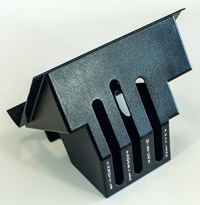Frugal Flier: Self-made upgrade
Real-world savings from 3D printing
 The owners of a 36-year-old Beech Sierra came up with a digital solution to an increasingly widespread real-world problem. They needed to replace a non-structural part (in this case, a cracked and crudely repaired throttle quadrant cover), and new ones were either unavailable or absurdly expensive. Their solution: 3D printing (see “P&E: Control+P,” March 2013 AOPA Pilot).
The owners of a 36-year-old Beech Sierra came up with a digital solution to an increasingly widespread real-world problem. They needed to replace a non-structural part (in this case, a cracked and crudely repaired throttle quadrant cover), and new ones were either unavailable or absurdly expensive. Their solution: 3D printing (see “P&E: Control+P,” March 2013 AOPA Pilot).
Dennis Moyes, a partner in the 1977 Sierra, removed the old cover and made a digital representation of it using AutoCAD, a drafting and 3D computer modeling program. Such programs are increasingly common. (Others include 3D Studio Max, SketchUp, Rhino, and Blender.)
With an .stl file in place, Moyes sent it via Email to a company called Shapeways for “printing.”
Moyes had several choices for materials, and he selected one of the least expensive, a nylon-based composite at a cost of $130, just in case it didn’t fit right the first time.
“Of the available materials, I thought it was best balance of economy and strength,” Moyes said. “I chose the cheapest route in case I had to remake it. It turns out that the material was fine for the finished part.”
More exotic materials were available at prices up to $1,100.
The printed part arrived two weeks later. Moyes painted and detailed it, and the finished piece adds to the appearance of an already sharp-looking panel. Aircraft owners have wide latitude to create such “owner-produced parts” under FAR 21.303(b)(2) as long as the replacements aren’t for sale and are only installed in the owner’s airplane.
Email [email protected]


